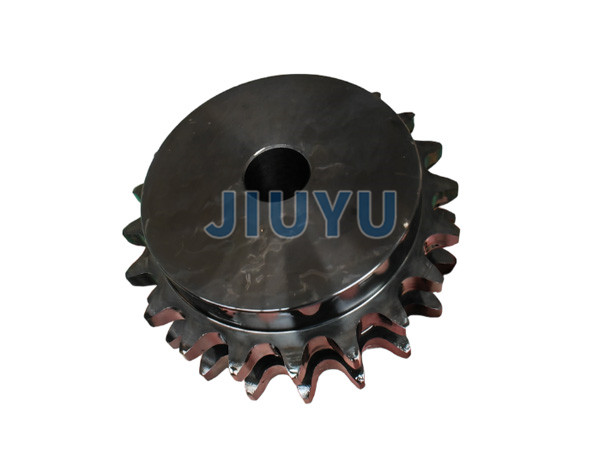
Product Details
The processing flow of industrial chain wheels is relatively complex. The following is the detailed processing process:
Design drawings: Based on usage requirements and working conditions, design detailed drawings of the sprocket and determine its dimensional parameters, such as number of teeth, pitch, outer diameter, inner diameter, tooth profile, etc Raw material selection: Choose suitable materials based on the usage environment and performance requirements of the sprocket. Common materials include 45 steel, 40Cr, 20CrMnTi, etc. For some sprockets with special requirements, stainless steel or other alloy materials may also be used. The quality of the material directly affects the performance and service life of the sprocket, so it is necessary to confirm that the composition and performance of the material meet the requirements Forging blanks: Heat the selected raw materials to the appropriate forging temperature range, and then use forging equipment for forging. Through multiple processes such as upsetting and stretching, the actual effect is to improve the internal structure of the main material, making it denser and more uniform, and enhancing the overall performance of the sprocket. Forge the approximate shape of the sprocket, leaving a certain machining allowance for subsequent processingMechanical processing
Turning processing: including turning the outer circle, end face, inner hole, steps and chamfers of the wheel hub, etc., to protect the requirements of dimensional accuracy and surface roughness.
Milling: Using a milling machine and a one-on-one chain wheel milling cutter to machine the tooth profile. According to the number of teeth and pitch of the sprocket, each tooth groove is accurately divided by the dividing head and milled in sequence Drilling processing: According to the installation hole position requirements of the sprocket, drill holes on the drilling machine to confirm the accuracy of the drilling position Grinding processing: For some sprockets with high precision requirements, grinding processing may be necessary to further improve the dimensional accuracy and surface quality of the sprockets, especially the accuracy and roughness of the tooth surface Heat treatment: Quench and temper the processed sprocket to improve the hardness, performance, and overall mechanical properties of the tooth surface. For example, for sprockets made of 45 steel material, the quenching temperature is generally between 820-840 ℃, and the oil quenching and tempering temperature is usually between 180-200 ℃ Surface treatment: In order to improve the corrosion resistance (based on actual reports), performance, and bite resistance of the sprocket, surface treatment can be carried out. Common surface treatment methods include galvanizing, hard chrome plating, blackening, phosphating, etc Quality inspection: Various testing methods are used to conduct comprehensive quality inspections on the sprocket, including appearance inspection, dimensional accuracy measurement, tooth profile accuracy testing, hardness testing, flaw detection, etc., to confirm that all indicators of the sprocket meet the design requirements and relevant standards Assembly and packaging: Assemble the processed and inspected sprockets with other related components, clean them, and then package them using appropriate packaging methods for transportation and storage


